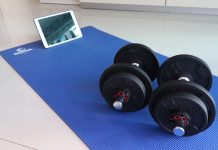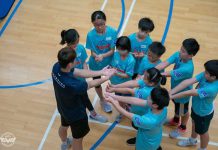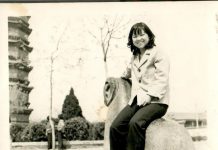Hong Kong’s leading ballerina shares her thoughts on life, love and the highly competitive word of ballet
Reporter: Dora Chiu
Jin Yao, dressed in black sweatpants, a simple T-shirt and a black hoodie, is taking a break from rehearsals. Her feet are cocooned in a pair of huge down slippers. But, despite the casual attire, her ballerina credentials are immediately obvious in her elegant poise, her slender, long neck and limbs.
Dance is in Jin’s blood. Both of her parents were professional dancers. They know how hard a dancer’s life can be: brutally competitive, physically gruelling and mentally demanding. So they were wary of letting their daughter follow in their footsteps.
Still, the young Jin took a keen interest in dance. From the age of seven she joined the amateur dance classes her mother taught in Jilin. Even then, the girl’s talent was clear; just by imitation, she could execute the steps that her mother’s students could not do.
Although her parents were aware she had the athleticism, musicality and innate agility needed to become a professional dancer, they were still hesitant about allowing her to follow their path. They hid the application forms for the Beijing Dance Academy away from the young Jin.
Jin says she found them in drawer quite by accident. In the end, her parents relented and allowed her to audition for the academy, China’s leading dance institute.
Jin was nine when she auditioned and her performance won her a place. Now she had to decide whether to choose folk dance or ballet. In the end, Jin picked ballet because she liked the beauty and elegance of classical ballet.
She started studying dance at the academy at the age of 10 and graduated seven years later, joining the National Ballet of China. She was promoted to principal dancer in 2003 and was later ranked a top-grade China National Dancer.
Despite a promising career in the National Ballet, Jin decided to join The Hong Kong Ballet as senior soloist in 2004. Jin wanted to explore more possibilities in her dancing and see things from a broader perspective. She could see there were big differences between the arts world in the mainland and in Hong Kong.
Jin says a wider repertoire is performed in Hong Kong because audiences here can truly appreciate art. “Hong Kong people are more westernized and willing to accept different values,” she says.
In comparison, the focus in the mainland is mainly on ticket sales. Only famous and bankable programmes like Swan Lake and The Nutcracker are performed there. Dancers rarely have the opportunity to try performing other works, and this limits their talent and exposure.
Jin is grateful to the Hong Kong Ballet for giving her the freedom and space to grow and discover herself. She says there were times in the National Ballet when she felt desperate. “I stayed at the National Ballet of China for seven years dancing the same routine day after day.” She adds: “The Hong Kong Ballet has given me a second life. . .In Hong Kong, I feel like I am really doing art.”
After being immersed in ballet for more than twenty years, Jin finds the most difficult part of ballet is persistence.
Success in ballet takes a lot of time and hard work, says Jin, but it also requires a measure of good fortune. Most ballet dancers do not even have the chance to be recognized. Once she started to practice ballet for real, she quickly learned the art form was not what she used to think it was.
“Ballet very much depends on technique, therefore regular basic training is needed every day,” she says. Ballet students in the Beijing Dance Academy are required to learn only the fundamental techniques in their first three years of study. Before they can learn how to dance they must first master the basic positions and moves and how to control their muscles.
But even for an accomplished ballerina like Jin, training is regular and rigorous. “You either improve or you fall back,” she says.
It is her desire for continuous improvement that drives her on. What Jin fears most is losing her ability to dance. She recalls the dark days she experienced a few years ago. “I suffered from a ligament tear which stopped me from dancing for half a year. The only thing I could do was stay in bed with my eyes open,” she says.“I felt like my life was being taken away.”
When she recovered, she was even more thankful for her gift and her opportunity to use it. Jin says there is a famous saying in ballet: “You love ballet, but ballet may not love you.” In order to be an outstanding ballet dancer, you need to have both talent and put in hard work. Sadly, not all those who love ballet and wish to pursue a career in it are blessed with talent.
Jin has seen many strive to succeed in ballet but fail to accomplish what they want. “I have to be worthy of the talent I have been given,” she says, adding this is one of her responsibilities to herself and her parents.
Making a living as a ballerina is a dream come true for Jin. Ballet brings her happiness and a sense of satisfaction, “I feel [my life] is very substantial. I never feel lost” she says.
Satisfaction also comes from the appreciation of others. In 2005, Jin was promoted to principal dancer of The Hong Kong Ballet. At the beginning of this year, she was awarded the Best Artist of the Year (dance category) by the Hong Kong Arts Development Awards 2010 in recognition of her hard work and remarkable performances.
“I am so surprised to know that many people actually keep an eye on me,” says Jin. She views this as encouragement to keep on improving herself.
But while she is satisfied with her career, Jin admits life as a leading dancer can be lonely. “It’s a trade off. I spend most of my time on ballet so I have less time to devote to relationships,” she says. Jin is very serious about relationships and is not interested in wasting time on people she does not really like. “If I meet the right man, I am sure I will fall deeply in love.”
She is aware of the high rate of divorce nowadays and stresses that she will not marry until she meets her soul mate and for Jin that means someone who is responsible, elegant, admires ballet, and most importantly, shares a common language with her. She dreams of having two childern with her future husband and hopes to lead an ordinary, happy family life.
For the moment, Jin’s priority is to take care of her family. As her parents’ only child, Jin maintains a very close relationship with them although she left home to pursue ballet when she was very young. She is sorry for not spending enough time with her parents and hopes to see them more often. “They have given me great support and that means a lot to me,” she says.
She is grateful to her parents for letting her pursue her dream but now that she is older she can appreciate and share the concerns they had about allowing their child to devote her life to dance.
“I will only let my children to take up ballet if their physical qualifications are good enough,” Jin says firmly, “If they do not have innate talent, they will never get to the point that they want to reach.”
Apart from longing for a blissful family life, Jin is also looking forward to trying new things, even things outside ballet. She is now 30, an age at which most ballerinas in the mainland have already retired. While she has no immediate plans to retire, she has already has plans for post-retirement life.
Jin is looking at the possibility of going back to school to study management or entering the world of fashion. She excitedly recalls that she had a lot of fun when she served as a model for Elle magazine last year.
But bowing out from the stage does not mean leaving ballet behind. No doubt she will embrace new endeavours with the energy she has invested in her dance career, but ballet will always run through Jin Yao’s veins.
“I hope to continue with ballet, through coaching, just like my mother did,” she says.










































